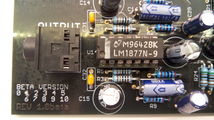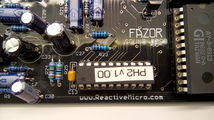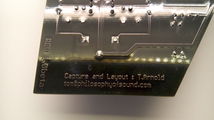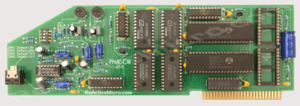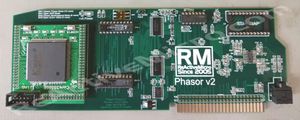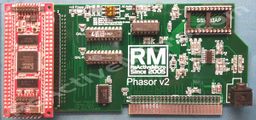Phasor: Difference between revisions
No edit summary |
|||
| Line 30: | Line 30: | ||
== Phasor Versions == | == Phasor Versions == | ||
[[Image:P_20180916_112027_vHDR_Auto-Wiki.png|thumb|AE Phasor Rev. F]] | [[Image:P_20180916_112027_vHDR_Auto-Wiki.png|thumb|AE Phasor Rev. F]] | ||
AE released the Phasor in 1984, and it's | AE released the Phasor in 1984, and it's believed all these early boards are marked "Rev. E" and are missing the 74LS245 near the card's edge connector. This "Rev. F" is from about 1986 and has the 74LS245. It's believed the change was due to a possible issue with the newer IIgs. And from a design standpoint should have been on the card to begin with to comply with Apple's specs as it drives the data bus. | ||
| Line 56: | Line 56: | ||
</gallery> | </gallery> | ||
This is the proto project for v2 of the project. It will be based in an FPGA and allow the board to be produced more cheaply when the 6522 and AY ICs become more scarce. However it probably won't be able to offered in kit form. | This is the proto project for v2 of the project. It will be based in an FPGA and allow the board to be produced more cheaply when the 6522 and AY ICs become more scarce. However it probably won't be able to be offered in kit form. | ||
<gallery class="center" widths=300px caption="Pics Of The Phasor v2 Alpha PCB"> | <gallery class="center" widths=300px caption="Pics Of The Phasor v2 Alpha PCB"> | ||
File:Phasor_v2_Alpha1.jpg|First Alpha Design | File:Phasor_v2_Alpha1.jpg|First Alpha Design | ||
Revision as of 04:37, 9 June 2019

The Phasor is a 12 voice sound card for the Apple II/II+/IIe/IIgs designed by Applied Engineering (aka - AE).
The Phasor is usually seen as one Mockingboard by programs which support the Mockingboard. Some programs can even see the Phasor as two Mockingboards, which allow for all 12 voices to be used. Other programs will directly support the Phasor, however the list is much smaller than those that support the Mockingboard.
In 2016 Tom Arnold worked with ReActiveMicro to reproduce a clone of the board called "FAZOR" v1.0beta.
On June 6th, 2019 ReActiveMicro released their own v1.0 Phasor project. This is what is currently offered for sale.
Project Status: Complete. In production. Actively sold by ReActiveMicro. Henry is working on v2 which will use custom logic to emulate the ICs.
Support: Post on the Discussion page (link above) or email ReActiveMicro Support.
Sales: Visit the ReActiveMicro Store.
History
The Phasor was the second project collaboration between Tom Arnold of philosophyofsound.com and Henry from ReActiveMicro. After a bit of market research there seemed be enough demand to warrant this project. Previously Tom had worked on and released a clone of the Mockingboard. This project however would be more difficult since the Phasor uses two PAL devices.
About mid-February 2013 Henry sent Tom a Phasor to depopulate and start the cloning process as Henry was planning to be busy with other non-Apple II related business till about 2014. Tom produced a schematic and then relaid out a new PCB for alpha testing. This would allow testing of the schematic and new components.
Tom worked with the project in his spare time during 2013 and 2014. There was no major rush in the project since Ultimate-Micro still had stock of the Mockingboard v1a they were selling. Not much was done with the project till about mid-2015, after the Mockingboard v1a stock was liquidated.
During the whole process Tom had been trying to copy the protected PAL devices. After several weeks Tom managed to produce a good copy of "PH1". "PH2" however proved to be a lot harder to copy. Henry sent the PH2 device to JammArcade.net who specializes in duplicating older PAL devices. After several weeks they managed to produce a working copy about the very end of 2015.
From 2016 till 2019 Tom Arnold didn't produce any more Phasors. Henry decided to have more units produced with the main goal of also supplying kits. On April 4th 2019 Henry started working on the Phasor v1.0 project. He scanned the PCB, produced new CAD files, and revised the component layout and BOM. The main changes to the project compared to AE was to remove the old RCA audio jacks and use a more common 3.5mm jack, and to remove the thumbwheel potentiometers which set the output volume. The output volume is now hardset at a suitable level for use with amplified speakers most commonly found with desktop PCs.
Phasor Versions

AE released the Phasor in 1984, and it's believed all these early boards are marked "Rev. E" and are missing the 74LS245 near the card's edge connector. This "Rev. F" is from about 1986 and has the 74LS245. It's believed the change was due to a possible issue with the newer IIgs. And from a design standpoint should have been on the card to begin with to comply with Apple's specs as it drives the data bus.
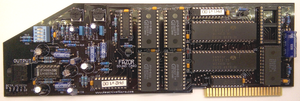
At the very end of June 2016 Tom sent ReActiveMicro a working Fazor v1.0beta clone for testing and to include in their raffle at KFEST 2016.
The silkscreen shows "ReactiveMicro.com" on the lower front left.
- More Pics Of The Fazor v1.0beta
-
The front "beta" marking on the Fazor.
-
The "ReActiveMicro" marking on the Fazor.
-
The rear "beta" and "Tom" markings on the Fazor.
The Phasor v1.0 is the current release of the project. Three exact 1-to-1 sample boards were produced to prove the CAD files and Bill of Materials was correct and factory assembly wasn't an issue. After that the pots were removed and resistors added to set the output volume level. Also removed were the RCA connectors and a more common 3.5mm audio jack was installed. This allows standard desktop speakers to be used.
- Phasor v1.0.x From ReActiveMicro
-
The Phasor v1.0.0. Only three with audio pots were produced.
This is the proto project for v2 of the project. It will be based in an FPGA and allow the board to be produced more cheaply when the 6522 and AY ICs become more scarce. However it probably won't be able to be offered in kit form.
- Pics Of The Phasor v2 Alpha PCB
-
First Alpha Design
-
Second Alpha Design
ICs Of The Phasor
The main control of the AY-3-8913 Sound Generator ICs is controlled by the 6522 Versatile Interface Adapter (VIA). The Apple II sends commands to the VIAs and the VIAs are connected in a way to send packages of instructions to the Programmable Sound Generators (PSG), and the PSGs produce audio.
The Apple II clock is phase shifted by 180 degrees on the Phasor using an RC Network and a 74HCT02. Part of the Apple II Audio Input circuit is also routed through the 74HCT02.
The SSI-263AP Speech Synthesis IC is not controlled by the VIAs, but is controlled by the onboard GALs. The GALs also produce clock for the PSGs and help control the VIAs.
FPGA Emulation Of Analog ICs
At the heart of the Phasor v2 sound card project is the emulation of the 6522 VIA's and AY-3-8913 Sound Generator ICs.
The FPGA reproduces audio using the same techniques as the Sound Generators. The Digital to Analog Converter (DAC) takes the commands from the 6522 part of the code and modulates the output accordingly. Pulse Width Modulation (PWM) is responsible for mixing and levels. The audio produced is very close to analog. The only real difference is the analog parts of the AY-3-8913 Sound Generator are never the same from IC to IC whereas they are always the same from FPGA to FPGA. The analog audio from the Sound Generators tends to be more "warm" however the audio from the FPGA tends to be more clear. Some high tones tend to be lower or washed out in analog when compared to digital samples. This could also be related to poor design of the filter circuits on the original AE Phasor.
OpAmp And Audio Mixer Circuit
The mixer circuits on the original AE Phasor were not of the best design. Radio Frequency Interference (RFI) and other related noise, channel bleed, and voltage level issues can all be heard on the original card. The Analog and Digital ground separation is also not of the best design. All of these issues were addressed on the ReActiveMicro project.
RFI tends to be heard with CPU, bus, and drive operation and can sound like clicks or slight beeps of varying tones. It's mostly heard when there is no or low audio and the volume is turned up or headphones are used. Channel bleed can be hard when audio is being played in one channel and silence in the other, and can make audio sound more mono or distorted in some cases. Voltage level issues tend to lead to some things sounding louder or softer than others. For example the speech IC tends to sound louder than sound effects or music.
In the Phasor v2 project the second speech IC option was removed since it was unused by all programs and even the test program. There was no known way to test it and no programmers from the Community could be found to help write better test software. In the current Phasor project the right and left channels for speech are combined for mono output which sounds a lot better than the original signal channel, and the voltage level was normalized to better match the audio output.
Documentation, Files, and Software
This is the original AE Phasor test software. It is very limited is what it tests, and due to these limits development of the Phasor v2 project has been delayed. It has been very difficult to find and fix issues as a result. It was our hope that at least one of the many programmers in the Apple II Community would have stepped up to help however this has not been the case. Most of the test software project is actually very simple as the code all exists in all the original test programs. All that's needed is for a programmer to piece it all together in one simple to use program with options as to which channel or voice to test.
This lack of support tends to plague the Apple II Community in general, and delayed projects and after release patches are a result. Also new programs or games of lesser quality are produced since the programmers don't have any experience with the hardware. It really is a lose-lose situation for everyone of the Community.
